Life is Art and Art is Life with Victor Maloney: Part Two
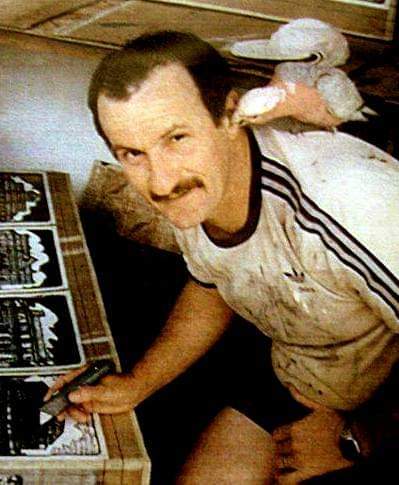
In the Organic 3-D Art style as Victor terms it, each painting creates a narrative which literally weaves its way around the composition aided by the inclusion of printed words which have become the signature of this incredible artist with so much to say visually. Victor does in fact define himself as an artist writer.
We will come to the printed word feature of Victor's paintings in a post to follow. But today we stay with Victor in Outback Australia by taking a 4 hour drive to the east of Broken Hill in New South Wales, to Cobar which was first settled by Europeans in the mid 1800s and became a mining town in the 1870s following the discovery of copper and gold.
In these two mining paintings Victor has used local minerals to enhance the impact - a medium used by local Broken Hill artist Kevin "Bushy" White whom we featured a couple of years ago.
I do like the dramatic effect Victor has achieved in these images and the way he has used perspective to draw in the viewers to feel part of the scene.
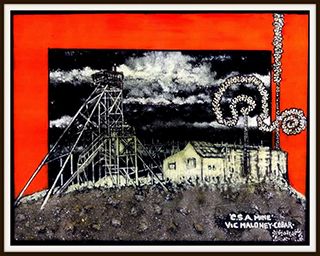
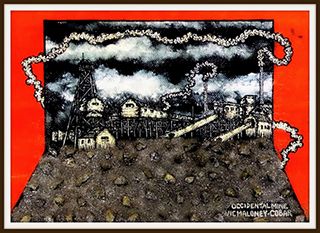
But like most naive artists Victor does like to emphasise the human aspect of the environment, the life of the people, who in this environment, are predominatly miners.
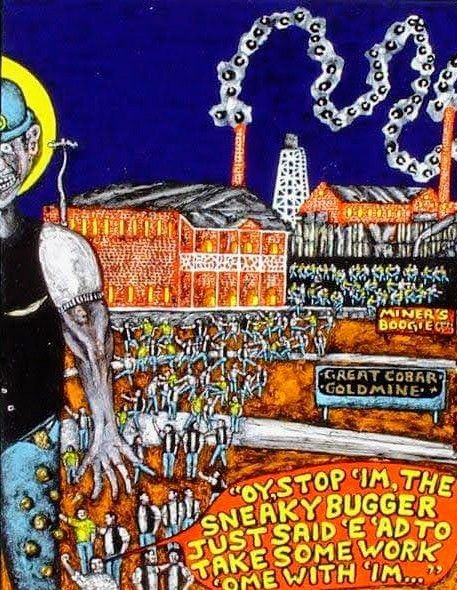
Please take time to study the chapters of the painting shown above and you will discover some nuggets of learning about Victor's perception of the environment. Note the repetition of the near stick figures which occur as one of the motifs in other Victor Maloney paintings.
As Victor explained in yesterday's post: My art world was reignited by a chance meeting with the late Broken Hill Art legend Pro Hart, while living in the silver city. Since then, the Art has travelled around the world to some interesting collections, and I’ve been able to absorb the mining scene is Cobar, the wildlife of Tasmania, especially the influence of the Tasmanian Tiger, the skyscrapers of Brisbane and now the seaside wonders of Victor Harbour, especially the pelicans.1
We will come to these other destinations as we progress through the series of posts but today it is a Maloney View of Cobar.
Victor's miners take on new life in "What the... (below) and isn't it amazing how he has been able to capture the expression of horror on their faces even though the figures aren't large. Victor is an expert at capturing emotions as we saw in the portraits of Pro Hart yesterday.
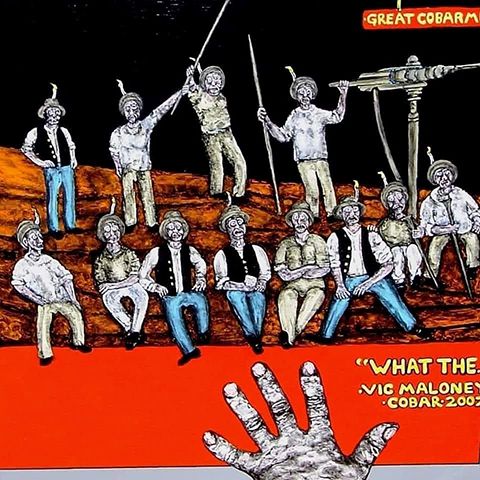
Victor tells us that:
after being projected back into the art world with a brush with a Broken Hill art legend and mentor (Pro Hart) I’ve experienced many adventures in the art world around Australia.
Some of these include the forced landing of a hot air balloon from 2000 feet while studying the outback terrain...and spending a week locked away in a primitive cell in Adelaide, South Australia in the old jail to transform the experience onto canvas while in the cell.
I also saw some things outside of the lock up area that still defy explanation... and I almost drowned while working on a painting in my bath tub in Cobar...1
From these tales we can conclude that there is no doubt that Victor lives his tenet to the fullest extent possible - Life is Art and Art is Life. And I am quite sure that Victor likes to surprise his audience and so was probably delighted at the commission work to paint an Easter Island Mural to brighten up a back tin fence in Cobar - thousands of kilometres from Easter Island!
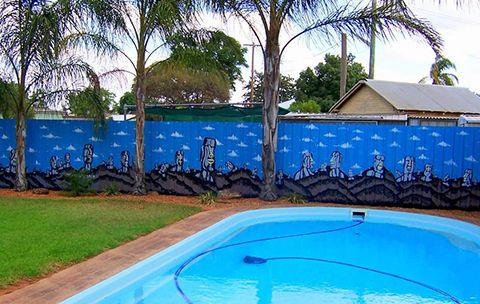
One of the most distinctive features of Victor's paintings is the way he portrays buildings which are often central to the background of the narrative - if that isn't a contradiction in terms!! But in many Maloney images there is a substantial building or two behind the main players who are on centre stage carrying his message or messages.
Below are three paintings which haven't had to share to stage with characters but rather are used to show Victor's love of buildings which are of course central to a community - especially the local pub. His Cobar buildings give us an excellent opportunity to study Victor's painting techniques a little closer.
The Great Western Hotel painting (below) was attached to an electric light box and hung on the wall behind the bar. Sidney Kidman, popularly named "the Cattle King", an Australian pastoralist and entrepreneur used to often frequent the hotel.1
And Barney's on Becker is a collage work, featuring an historic Cobar building once the residence for a soft drink factory, then the home for one of the family, then a restaurant.
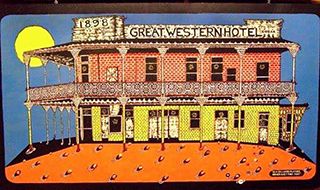
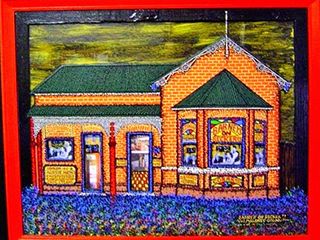
The brick pattern is another motif in Victor's paintings and as a lover and student of bricks myself I can attest to the fact that bricks are literally the building blocks and mortar of a community in any era and any country. They symbolise more than permanence, they represent the painstaking process involved in producing handmade bricks in early days with the painful backbreaking laying of each one, line after line, row upon row - building up storeys and stories to last for hundreds of years. They represent the changing of style over time whilst maintaining a certain resemblance to the past - I guess just like the people they protect from the elements!!
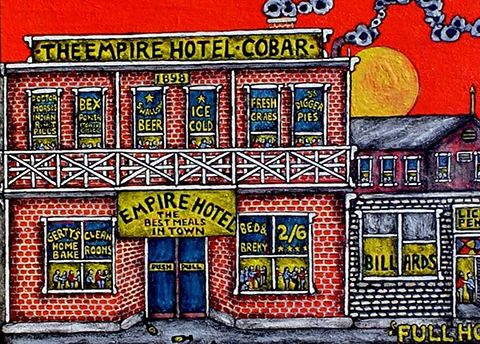
As Victor emphasises: ANYWAY, ''IT'S THE HEART ABOVE THE ART'' & ART IS ''THE INHALATION & EXHALATION OF LIFE ITSELF..''
And Victor embraces so many aspects of art - as a painter, writer and also guitarist.
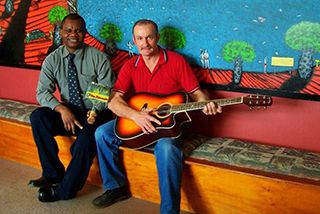
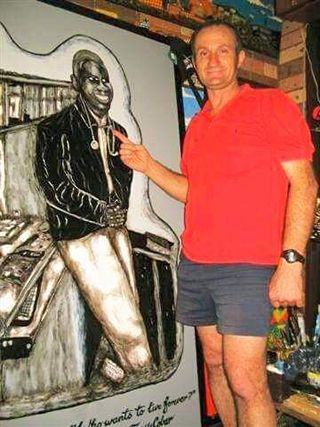
This artist has not only lived and embraced the big country of outback Australia and its people he literally sees the big picture. We have seen his Easter Island mural in Cobar (above) and earlier a mural in Victor Harbor, South Australia where he now lives.
But this one below takes the cake - in my opinion. The giant painting was produced by Victor to celebrate Cobar's World Premiere of the cult movie Bondi Tsunami!
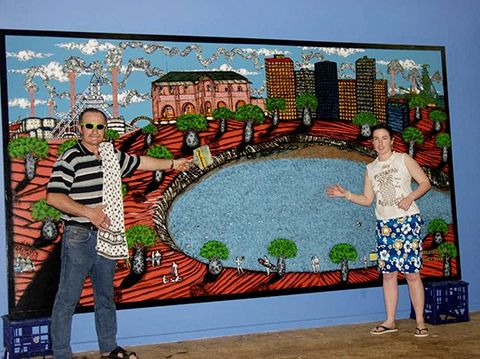
Bondi Tsunami is a 2004 feature length Australian indie film directed by Rachael Lucas, inspired by young Japanese tourists who come to Australia on working holiday visas in search of sun and surf. The film plays as a road movie about Japanese surfing culture, told through a series of extended montages set to music, interspersed with poetic zen musings. Much of the film's dialogue is in Japanese, with little English spoken despite the Australian setting. The movie was billed as "The first Japanese surfing road movie in Australia." Although unable to secure an official cinema release due to its limited appeal, the film has attracted a cult following based on its controversial style.2
But Victor is very worried about thousands of tourist descending on Cobar as he so emphatically emphasised, with his Australian sense of humour, in the painting Don't Come to Cobar....!!
As he says, the painting is a play on words... saying not to go there, if you don't want some adventure. The painting was sent to The U.S., as a Rotary goodwill project.
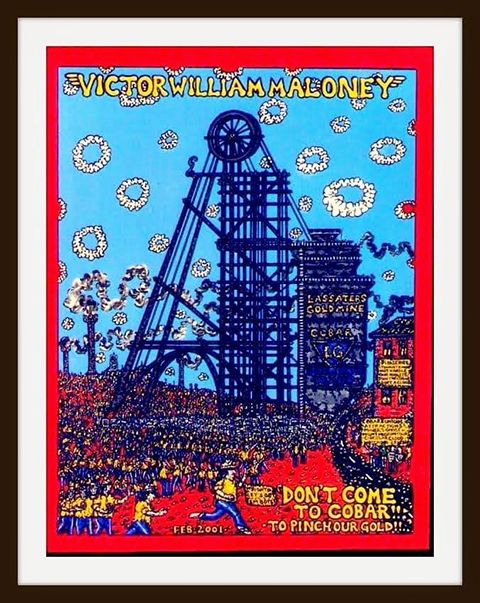
I think Victor Maloney and his paintings could be the best tourist advertisement Australia could possibly have!
We will be back after Christmas to move with Victor to the unspoiled natural wellness of Tasmania as he found it back in 2007 ... and to meet a Thylacine or two!
© Thank you to Victor Maloney who kindly gave permission for the images of his work to be shared on AnArt4Life.
You can follow Victor on Facebook by clicking here and on Instagram by clicking here.
Credit
1. Correspondence from Victor Maloney
2. en.wikipedia.org
